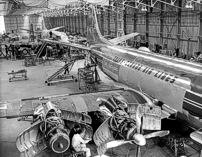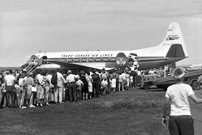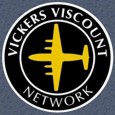
March 1956 to June 1964
Trans-Canada Air Lines (TCA)
CF-TGX - c/n 142 - a V.757 series Viscount
Canada registered
August 1954
An order was placed by Trans-Canada Air Lines (TCA) for an initial batch of seven Type 757 aircraft as a follow on from the previous Type 724 order.
This order was placed before they had received their first 724!
This was the first one built.
The total order for Type 757 aircraft reached thirtysix in May 1957.
Production Aircraft No. 103 - the 103rd production Type Type 700 series Viscount built,
was the 63rd Viscount fuselage assembled at Hurn, Bournemouth, Hampshire, England,
and the 37th Viscount assembled at Weybridge, Surrey, England.
Production Order No. F01/757. Sales Order No. F01/76B. Stock Order No. F48/22B.
21 March 1955
TCA issued technical instruction V-05.04-1/1 to apply the word 'Viscount' to the tail section in 8.5 inch high red letters edged in white at the first opportunity.
2 June 1955
TCA issued technical instruction V-31.02-2/5 to apply the word 'Viscount' to the inside of the passenger loading door in 4 inch high red letters edged in white at the first opportunity.
21 September 1955
Fuselage assembly commenced at Hurn Airport, Bournemouth, Hampshire, England.

Erecting Shop 'E' at
Weybridge, Surrey, England
November 1955
Fuselage transported by road from Hurn Airport, Bournemouth, Hampshire, England to Weybridge, Surrey, England.
11 November 1955
Fuselage to Erecting Shop 'E' at Weybridge, Surrey, England.
16 December 1955
Certificate of Registration and Airworthiness issued by the Canadian Department of Transport which covered the delivery flights to Canada.
18 March 1956
First flight from Brooklands Airfield, Weybridge, Surrey, England.
It was fitted with Rolls-Royce Dart RDa3 Mark 506 engines.
It landed at Wisley Airfield, Surrey, England for fitting out and test flying.
23 March 1956
Aircraft passed off by TCA inspectors as completed and ready for delivery.
The word 'Viscount' had not been added to the tail at this stage.
28 March 1956
Departed from Wisley Airfield, Surrey, England on delivery to Trans-Canada Air Lines (TCA) with fleet number '616'.
After refuelling at Prestwick Airport, Ayrshire, Scotland it then flew on to Keflavik Airport, Iceland but had to return to Prestwick for some reason.
Later the same day they departed from Prestwick Airport, Ayrshire, Scotland to Keflavik Airport, Iceland (743 nautical miles) where they stopped overnight.
29 March 1956
Departed from Keflavik Airport, Iceland to Bluie West One (BW1) Airfield, Narsarsuaq, Southern Greenland (804 nautical miles), Dorval International Airport, Montreal, Province of Quebec, Canada (1482 nautical miles). They must have had a very strong tailwind to miss out Goose Bay!
BW1 was built during WWII to assist the transfer of military aircraft from North America to Europe and was opened in January 1942.
The cabin seating was installed in Canada, as the seats used by TCA were of American manufacture.
The cabin was fitted out with 40 seats which was a reduction from the original 48 seat specification and provided more leg room.
This was heavily marketed and resulted in a high load factor compared to the 18 seat Douglas DC-3 that it replaced on some routes.
15 June 1956
Delivery flight Certificate of Registration and Airworthiness expired.
July 1956
Cabin interior changed to a two class 44 seat arrangement.

'Open House Day'
at Thunder Bay Airport
10 July 1957
TCA issued instructions that all Viscounts would be repainted in a 'White Top' livery when a suitable maintenance period became available.
July 1958
Opened up to the public during an 'Open House Day' at Thunder Bay Airport, Ontario, Canada.
11 April 1959
Suffered an accident at Hopkins International Airport, Cleveland, Ohio, USA.
No more information is known. Details please to information@vickersviscount.net.
31 August 1960
Total time 11,560 hours and 9,197 total landings.
1 June 1964
Transferred to Air Canada due to a corporate name change.
|



